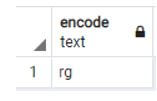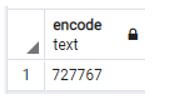Updated May 24, 2023
Introduction to PostgreSQL encode
PostgreSQL provides an encode function to the user. The encode function is a binary string function in PostgreSQL. An encode function is used to encrypt the data from one form to another by using some parameter. Encode function is used to convert binary data into a text representation, and it supports different formats such as Base64, Hex, and Escape. Normally Base64 is used to translate or encode the string. PostgreSQL provides other encode functions such as Base64, MIMEHEADER_ENCOD, TEXT_ENCODE, and QUOTED_PRINTABLE_ENCODE. We use E for string (escape string) and casting purposes, we use bytea; the result will be the encoding.
Syntax:
select encode(string text, type of text);Explanation:
- In the above syntax, we use the select clause with encode function; the string type means we use E or escape string that we need to encode, and the type of text means the actual format of the text that supports a different format we already mentioned in the above point.
How encode Function work in PostgreSQL?
Let’s see how to encode function works in PostgreSQL:
- The PostgreSQL encode function has two input parameters: first, for the text or string with casting property, and the next is that binary textual format.
- Whatever parameters encode a function should be the same as a decode function.
- The encode function in PostgreSQL will return a binary textual format with a specified binary format.
Encode supports different textual formats of string as follows:
Base64:
When we talk about base64 in programming, it is a group of binary to text conversion schemes used to represent binary data. In base64, the end of the line is used instead of the MIME CRLF end-of-line marker to determine the end of the line. With the help of RFC line is encoded by using 76 characters.
Let’s see some examples of Base64 in the below table.
| Sr.No | Binary Bit | Characters |
| 0 | 000000 | A |
| 1 | 000001 | B |
| 2 | 000010 | C |
| 3 | 000011 | D |
| 4 | 000100 | E |
| 5 | 000101 | F |
This way, we can convert all binary bits into characters, as shown in the table above.
- Escape: The escape format converts zero bytes with high byte set into the octal escape series and remaining all bits, or we can say that values are represented literally.
- Hex: In hex structure, it represents every 4 bits of text like one hexadecimal digit such as 0 through the F. After applying to encode function, the out will be in lower case like a-f hex character because lower case letters represent 8 bits.
On the other hand, the encoding function in PostgreSQL uses different binary string functions and operators.
Examples of PostgreSQL encode
Given below are the examples of PostgreSQL encode:
Code:
select encode(E'r\g'::bytea, 'escape')Explanation:
- In the above example, we use a select clause with the encoding function here, E represents escape, r\g is a string that we need to encode one form into another, and escape is the textual format, as shown above, for example.
- Let’s see the end output of the above-mentioned statement by using the following snapshot.
Output:
Code:
select encode(E'sample'::bytea, 'escape')Explanation:
- See in the above example, we directly pass the string without any backslash and remain this same as it as shown in the above statement.
- Let’s see the end output of the above-mentioned statement by using the following snapshot.
Output:
Let’s see an example by using base64 textual format as follows:
Example #1
Code:
select encode(E'rw\g'::bytea, 'base64')Explanation:
- In the above example, we use a select clause with encode function, as shown here. E is used to escape, and between single text is a string that we need to convert into another format, and bytea is used for casting purposes. Finally, base64 is a textual format used by the encoding function.
- Let’s see the end output of the above-mentioned statement by using the following snapshot.
Output:
Let’s see another example by using the hex format as follows.
Example #2
Code:
select encode(E'rw\g'::bytea, 'hex')Explanation:
- In the above example, similarly to the previous two examples, we use a select clause with encode function, inside the bracket, we write the first string that we need to convert; after that, we use bytea for casting purposes, and finally, we use hex textual format for encoding the string as shown in the above statement.
- Let’s see the end output of the above-mentioned statement by using the following snapshot.
Output:
We can directly encode the string.
Let’s see an example as follows:
Example #3
Code:
select encode('sample','base64');Explanation:
- In the above example, we just used a select clause with encode function, and inside the bracket, show a string that we need to convert, and the parameter is binary textual format as shown in the above statement.
- Let’s see the end output of the above-mentioned statement by using the following snapshot.
Output:
For server-side encoding, we use some commands as below:
Code:
\l\l command is used to list the entire database with all details.
For client-side encoding, we use the following command as follows:
Code:
show client_encoding;Explanation:
- After executing the above statement, it shows the client-side encoding.
- Let’s see the end output of the above-mentioned statement by using the following snapshot.
Output:
Let’s see how we can insert encoded values into the table as follows:
First, we create a table by using the following statement, here, we create a class table with different parameters.
Code:
create table class(id serial primary key,subject_name varchar not null,
class_start_time time not null, class_end_time time not null);After that, we insert some records into the class table by using insert into a statement as follows:
Code:
insert into class(subject_name,class_start_time,class_end_time) values
(encode('PostgreSQL','base64'),'08:00:00','09:00:00'),
(encode('English','base64'),'10:00:00','11:00:00'),
(encode('IT','base64'),'7:00:00','08:00:00');
select * from class;End result of the above statement we illustrate by using the following snapshot.
Output:
Conclusion
From the above article, we have seen the basic syntax of encode function means how we can encode the string. We have also seen how to implement them in PostgreSQL with different examples of each binary format type. In this article, we have seen how we can maintain the security of data and how we can maintain a safe environment. From this article, we have seen how we can handle encode functions in PostgreSQL.
Recommended Articles
We hope that this EDUCBA information on “PostgreSQL encode” was beneficial to you. You can view EDUCBA’s recommended articles for more information.










